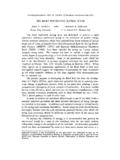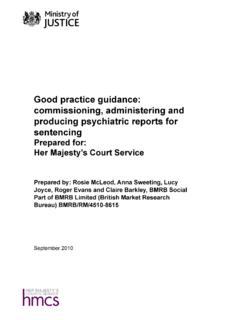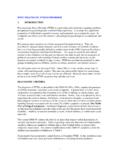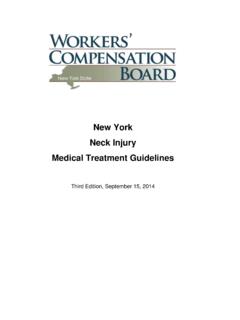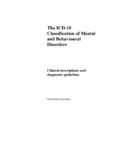Transcription of pseudohypacusis - NTUH
1 pseudohypacusis First used by Carhart in 1961. A person presents with a hearing loss not consistent with clinical or audiological evaluation, without organic lesion. Terminology: pseudohypacusis , functional or nonorganic hearing loss. Conscious: purposefully, malingering / feigning, simulated hearing loss. Unconscious: psychogenic, hysterical. Most commonly encountered in adult patient, Men >> women. 15% malingerers, 30% emotional disorders, 48% unclassified. Psychogenic: women > men, 40~60 y/o Major depression, personality disorder, anxiety disorder, conversion disorder. Motivation in adult: to shirk responsibility or receive financial compensation, medical or legal suit. Children: (1) a condition similar to adult malingering; (2) psychogenic or other functional factors; (3) improper testing techniques, unfamiliarity with the testing procedures, or attention disorders; (4) hearing loss for pure tones with good hearing for speech.
2 Organic causes of hearing loss must always be excluded by thorough clinical examination and testing. Several authors feel that the condition is missed or overlooked. Prevalence and etiologic factors Highest prevalence in special populations in whom decibels of hearing loss could be translated into dollars of compensation. 1956 McCoy, 10yr study after WWII: veterans 10~15% 50% 1. changing the method of compensation from a single lump-sum award to a monthly payment. 2. use of crude hearing test ( conversation voice) as a basis for verifying hearing loss. 3. inadequate counseling when the hearing loss was discovered initially. 1980s Atack R: soldiers among basic trainees and combat units: 4~5% Industrial workers who are exposed to high noise levels 1970s: Barelli, et al.: 24%; Gosztonyi, et al.
3 : 34% 1994: Barrs, et al: 9%. 1998 Qiu: in 4720 patients. General population: ~2%. Children: ~ of 2300 school children. in sudden deafness. 1 Failure to diagnose the condition may result in reinforcement of the disability and subsequently the inappropriate prescription of aids or continued social or educational problems. Once the diagnosis has been established, there should be little interference. Childhood pseudohypacusis Peak incidence: 10~12 y/o, girls > boys. Failed school routine hearing assessments. Subjective hearing loss after resolved middle ear disorder. Previous history of ear problems (27% otitis, 16% ear surgery), trauma(33%). The classic presentation: Responds normally to conversation but gives an audiogram with sensorineural loss. PTA: 40~70dB loss with a fairly flat or occasionally slightly saucer-shaped curved.
4 Usually of normal or above average intelligence from a background of high academic achievement where there is pressure to perform well in exam Excuse for their less than satisfactory school performance. Serves as an acceptable reason for parents and teachers to account for poor academic performance. Child s need to gain attention, a means of gaining sympathy. Aggressive behavior at school, strong sibling rivalry at home, social conflict. pseudohypacusis may indicate underlying problems that merit detailed investigation and treatment: concurrent speech problems, associated psychiatric problems. Usually associated with an identifiable conflict with the parents, friends or teachers. Psychological defence mechanism by which subconscious emotional conflict is translated into physical disability. Neurological symptoms associated with conversion disorders.
5 Even exhibit nonorganic visual problems. Attention deficit, ADHD. pseudohypacusis should be relatively easy to diagnose in children because of the problems they have in producing inter- and intra-test consistency. pseudohypacusis remains an under diagnosed condition in children but that, once suspected, the diagnosis can be quickly established using available audiological tests. Diagnostic tools Simple audiological tests such a repeat pure-tone audiometry, impedance testing and speech audiometry are usually sufficient to diagnose pseudohypacusis . Pure-tone audiometry (PTA): Inconsistency in response, poor reliability, 15dB difference between tests. Test-retest agreement: + 5~10dB in normal cooperative patient. The need for repeat pure-tone audiometry at a later date to confirm the diagnosis.
6 2 The pseudohypacusic patient must use some judgment of loudness as a gauge for admitting or denying awareness of the signal. Pure tone audiograms in these cases showed bilateral in most cases, symmetrical curve, sensorineural in type, flat and sloping in shape (including saucer type), and its hearing level revealed in 30-40dB in most cases. Alternately ascending and descending tone presentation to increase the difficulty of maintaining a falsely elevated threshold. Harris: tests the patient in ascending rather than descending steps by which it is possible to increase thresholds by 20-30 db. Speech audiometry, speech reception threshold (SRT): Paeusohypacusis: SRT-PTA difference 10~15dB or better SRT (24%~70%) SRT first and then PTA. In normal cooperative patient: SRT-PTA difference + 6~8dB Ascending procedure: SRT-PTA difference 10~20db in pseudopyoacusis.
7 To deceive the child into the belief that the testing has not begun and ask them to help in a check of the equipment. Pracy: speech audiogram alone is sufficient in the vast majority of cases. Acoustic reflex: In normal hearing, the acoustic reflex is usually elicited at hearing thresholds ranging from 70 to 95 dB. Absent in conductive pathology Suggestion audiometry, Suggestion speech audiometry (Hiroshi, et al. 1999): it is suggested to the patient that hearing will be improved as a result of the test procedure, pseudohypoacusis due to unfamiliarity with the testing procedures Testing the auditory acuity of each ear, Utilizes the response of the phantom sound image in the head by simultaneous binaural presentation of sound stimulation. Normal: the phantom sound image is formed in the median plane of the head by the equal suprathreshold tone level presented simultaneously in each ear.
8 Brainstem evoked response audiometry, audiotory brain stem response (ABR): True hearing thresholds, it lacks simplicity and convenience and is also relatively expensive. ABR threshold agree within 10dB of voluntary pure tone threshold. In those cases where doubt remains in spite of correlation between the pure tone and speech audiograms, A powerful tool in the assessment of pseudohypacusis . ABR may convince the patent to give up an attempt at pseudohypausis. Electrocochleography. (ECoG): Measuring and recording the evoked electrical activity that originates within the cochlea and the auditory branch of cranial nerve VII in response to auditory stimuli. Otoacoustic emissions: 3 Assessing the cochlear function, non-invasive, objective diagnostic technique, time-saving. Evoked OAEs: generated by the outer hair cells in the cochlea.
9 Transient evoked OAEs (TEOAEs) and distortion product OAEs (DPOAEs). TEOAEs are preferred over DPOAEs as TEOAEs are generated from a large portion of the basilar membrane and are influenced by the status of the whole cochlea. The recording of normal evoked otoacoustic emissions usually confirms normal middle ear and cochlear function, thereby ruling out a moderate to severe hearing loss and the presence of conductive components. , normal peripheral auditory function. When TEOAEs are present, hearing threshold 20dB would be predicted; absent in SNHL > 40db. Zone of uncertainty: 25~35dB Qiu et al.: the most rapid, economical and objective method Quicker, less subjective compared to speech audiometry and also not dependant on comprehension as with speech audiometry. Conversely, there may be normal audiometric thresholds in the absence of TEOAEs and this is indicative of subclinical cochlear damage.
10 Adult patients with noise induced hearing loss. Stenger test: Checks for the presence or absence of unilateral non-organic hearing loss. Determines true threshold in worst ear if non-organic hearing loss identified. LOCATION: Any audiology test room with two-channel audiometer capable of producing a pure tone signal in each channel simultaneously. PATIENT CATEGORY: All patients with an asymmetric hearing loss (>20dB difference between air conduction thresholds), where doubt as to accuracy of worse ear thresholds exists. Principle of test: This test works on the principle that if tones of the same frequency are presented simultaneously to both ears, only the loudest is perceived. The test can find a threshold in the worst ear of someone with non-organic unilateral hearing loss to within 10dB of the true threshold.



